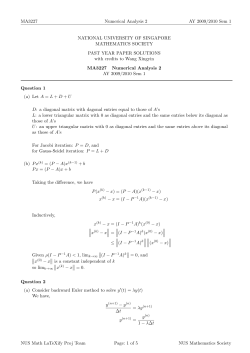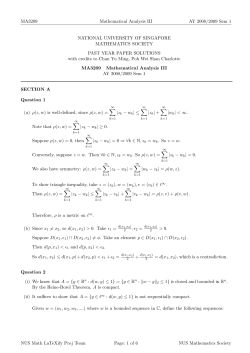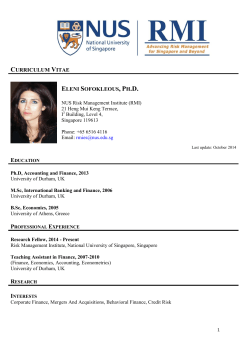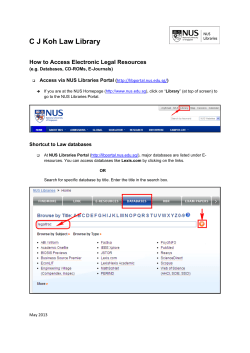
MA1101R Linear Algebra 1 AY 2008/2009 Sem 2 NATIONAL UNIVERSITY OF SINGAPORE
MA1101R
Linear Algebra 1
AY 2008/2009 Sem 2
NATIONAL UNIVERSITY OF SINGAPORE
MATHEMATICS SOCIETY
PAST YEAR PAPER SOLUTIONS
with credits to Wu Jiawei, Shi Xiaojie, Terry Lau Shue Chien
MA1101R Linear Algebra 1
AY 2008/2009 Sem 2
Question 1
(a)
(i) (w, x, y, z) = (w, x, w − x, 2w + x), (w, x ∈ R).
(ii) (w, x, w − x, 2w + x) = x(0, 1, −1, 1) + w(1, 0, 1, 2)
So V = span{(0, 1, −1, 1), (1, 0, 1, 2)}.
So V is a subspace of R4 .
(iii) For any a in V , a = x(0, 1, −1, 1) + w(1, 0, 1, 2).
(0, 1, −1, 1) and (1, 0, 1, 2) are linearly independent.
{(0, 1, −1, 1), (1, 0, 1, 2)} is a basis for V .
So dim V = 2.
(iv) Because dim V = 2, it is not a linearly independent set as v3 could be expressed as linear
combinations of v1 and v2 since dim V = 2.
(b)
(i) Since u1 , u2 , u3 are linearly independent. Therefore for the equality to hold
c1 u1 + c2 u2 + c3 u3 = 0
the only solution is c1 = c2 = c3 = 0.
To prove the linear independency u1 + u2 , u1 − u2 , u3 ,
d1 (u1 + u2 ) + d2 (u1 − u2 ) + d3 u3 = 0
(1)
Rearranging the above term, we have
(d1 + d2 )u1 + (d1 − d2 )u2 + d3 u3 = 0
Comparing the coefficients of ui with (1), d1 + d2 = 0, d1 − d2 = 0 and d3 = 0. Therefore
d1 = d2 = d3 = 0 which implies that u1 + u2 , u1 − u2 , u3 are linearly independent.
Now let x ∈ R3
x = c1 u1 + c2 u2 + c3 u3
c1 − c2
c1 + c2
(u1 + u2 ) +
(u1 − u2 ) + c3 u3
=
2
2
= d1 (u1 + u2 ) + d2 (u1 − u2 ) + d3 u3
Therefore T is a basis for R3 .
(ii) Let v1 = u1 + u2 , v2 = u1 − u2 , v3 = u3 . So u1
transition matrix from S to T is
0.5 0.5
0.5 −0.5
0
0
NUS Math LaTeXify Proj Team
Page: 1 of 5
=
v1 +v2
2
and u2 =
v1 −v2
2 ,
u3 = v3 . The
0
0
1
NUS Mathematics Society
MA1101R
Linear Algebra 1
AY 2008/2009 Sem 2
(c) Let ai = (0, 0 . . . , 0, 1, 0, . . . , 0), with the ith entry being 1. Let Vi = span{a1 , a2 , . . . , ai }.
Because a1 , a2 , . . . , ai are linearly independent, dim Vi = i.
{a1 , a2 , . . . , ai } is a subset of {a1 , a2 , . . . , ai+1 }. So it satisfies the condition.
Question 2
(a)
(i) The reduced row-echelon form of A is
1
0
0
0
0
1
0
0
1
0
0
0
0
1
0
0
1
0
0
0
(2)
A basis for the row space of A is {(1, 0, 1, 0, 1), (0, 1, 0, 1, 0)}.
2
1
2 1
(ii) A basis for the column space of A is {
3 , 3 }
1
0
(iii) Let Ax = 0. Referring to (2)
We get x = s
1
0
−1
0
0
+ t
1
0
0
0
−1
+r
0
1
0
−1
0
.
with r, s, t ∈ R.
A basis for the null space is {
(iv) Add two vectors
(b)
1
0
0
0
0
and
1
1
0 0
−1
, 0
0 0
−1
0
0
1
0
into it.
0
0
,
0
1
0
−1
0
}.
(i) if rank(C)=1,
x−2=0
& x2 − x − 2 = 0
&
x+1=0
There is no real x that satisfy the simultaneous solution.
(ii) If rank(C) =2, either x − 2 6= 0 or x2 − x − 2 6= 0 or x2 − x − 2 = 0 and x + 1 = 0.
Case(i) x 6= 2, then x2 − x − 2 must be zero. Then x = −1.
Case(ii) x = 2, then x + 1 = 0.
Therefore x = 2 or −1.
(iii) if x 6= 2 and x 6= −1, rank(C)=3.
β1
(c) let B be β2 , where β1 , β2 , β3 are the row vectors.
β3
NUS Math LaTeXify Proj Team
Page: 2 of 5
NUS Mathematics Society
MA1101R
Linear Algebra 1
AY 2008/2009 Sem 2
For any α = (x, y, z) in the null space of B, Bα = 0.
So β1 α = 0, β2 α = 0, β3 α = 0, (a, b, c) belongs to the row space of B.
x
(a, b, c) = x1 β1 + x2 β2 + x3 β3 . So (a, b, c) y = 0.
z
So the nullspace of B is a subset of the plane ax + by + cz = 0.
Question 3
(a)
(i) r2 = r1 + r3 , ie. r2 is a redundant vector as a basis.
r1 · r3 = 0.
So S is an orthogonal basis for the vector space V.
(ii) Let u = x1 r1 + x3 r3 . Solving, x1 = 5, x3 = 4.
(u)s = (5, 4).
(iii) The projection of v onto V is
v · r3
1
4 4 10
v · r1
r1 +
r3 = r1 + r3 = ( , , )
2
2
|r1 |
|r3 |
3
3 3 3
(b)
2 0 −2 | 1
(i) Consider 1 2 1 | 1 .
3 4 1 | 1
1 0 −1 | 12
The reduced row-echelon form is 0 1 1 | 14
0 0 0 | − 38
Ax = b is inconsistent.
(ii) Consider AT Ax = AT b.
14 14 0
6
14 20 6 x = 6
0 6 6
0
s + 37
The least squares solutions are −s , (s ∈ R).
s
(c) Consider B T Bx = 0. rank(B T B)≤rank(B)≤ m < n.
So it has infinitely many solutions. So Bx = b has infinitely many least squares solutions.
Question 4
(a)
λ−4
0
0
0
(i) λI − A = −1 λ − 4
0
0
λ−5
2
det(λI − A) = (λ − 4) (λ − 5)
The eigenvalues of A are 4 and 5.
NUS Math LaTeXify Proj Team
Page: 3 of 5
NUS Mathematics Society
MA1101R
Linear Algebra 1
AY 2008/2009 Sem 2
(ii) λ1 = 4. Consider (4I − A)x = 0.
0
E4 = span 1
0
0
Similarly, we get E5 = span 0
1
(iii) dim E4 = 1, dim E5 = 1. A is not a diagonalizable matrix.
−1 0 0
(iv) Let B = 0 0 0 ,
0 0 0
3 0 0
A + B = 1 4 0 ,
0 0 5
0
0
A + B has eigenvalues 4 with respect to 0 , 3 with respect to 1 , and 5 with respect
1
0
−1
to 1 Hence. it’s diagonalizable.
0
(b) Let A =
1 2
1 1
,B =
2 0
0 3
−1 2
−1
.
. A =
1 −1
C = ABA−1 .
The eigenvalues of C are the same as B. The eigenvalues of C T are the same as C. So the
eigenvalues of C T are 2 and 3.
Consider (λI − C T )x = 0.
1
−1
, and the eigenvector corresponding to 3 is
The eigenvector corresponding to 2 is
2
−1
T
−1
T
T
T
T
−1
T
T
Alternatively, C = (A ) B A = (A ) B A , therefore we have
AT C T (AT )−1 = B T
−1
The eigenvalues are 2 with respect to eigenvectors
, and 3 with respect to eigenvectors
2
1
−1
(c) X is diagonalizable matrix with one eigenvalue λ. dim Eλ = n.
Consider (λI − X)x = 0, nullity(λI − X) = n. rank(λI − X) = 0. So λI − X = 0, X = λI.
Question 5
(a)
(i) A =
1 0 1
0 1 −1
.
(ii) Consider Ax = 0, ker(T )= {(s, −s, −s)|s ∈ R}.
(iii) rank(T )=rank(A)=2. nullity(T ) = nullity(A)=1
NUS Math LaTeXify Proj Team
Page: 4 of 5
NUS Mathematics Society
MA1101R
Linear Algebra 1
AY 2008/2009 Sem 2
1 0
(iv) AT = 0 1 .
1 −1
rank(T )=rank(AT )=2, nullity(T )=nullity(AT )=0.
1
0
(v) R(T )= the column space of A. Both
,
belong to R(T ). So R(T ) = R2 .
0
1
(vi) Let the standard matrix of T and S be A and B.
The standard matrix of S · T is I. I = BA. rank(I)≤rank(A)≤ 2.
It contradicts rank(I)=3. So it is not possible.
a b
Alternatively, one can let B = c d , and compute BA,
e f
a b
a b a−b
1 0 0
1 0 1
BA = c d
= c d c−d = 0 1 0
0 1 −1
e f
e f e−f
0 0 1
But if a = 1, then b = 1 and b = 0, which does not make sense. Hence it is impossible to find
such a S.
(b) Let the standard matrix of F be C. Let U = (u1 u2 . . . un ), V = (F (u1 ) F (u2 ) . . . F (un )).
U, V are orthogonal matrices. So U U T = In , V V T = In , F (ui ) = Cui for 1 ≤ i ≤ n.
V = CU . C = V U −1 and therefore CC T = I. So the standard matrix of F is an orthogonal
matrix.
NUS Math LaTeXify Proj Team
Page: 5 of 5
NUS Mathematics Society
© Copyright 2025

















